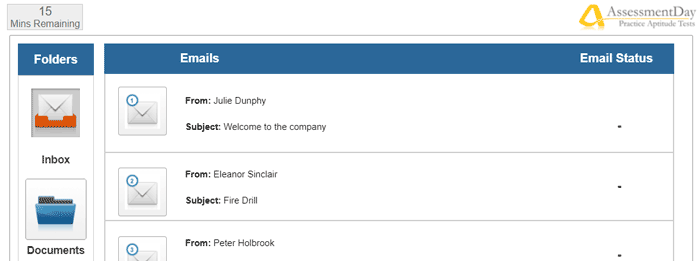E-tray Exercise
E-tray exercises are online computer-based versions of in-tray exercises.


Updated:
What is an e-tray exercise?
An e-tray exercise is a computer simulation of a work place scenario whereby you will have access to an email inbox. The inbox will include emails containing various data relevant to the exercise such as memos, newspaper clippings and reports which will be required at some stage in the exercise.
PRO TIP
Typically answers will be in multiple choice format and will progress in difficulty throughout the exercise, and some exercises will require a written element. It's your task to deal with the workload of this simulated scenario. You should prioritise the tasks and deal with them effectively.
Here is a partial screenshot of one of our e-tray tests. You can see you are presented with an inbox full of unread emails with attachments and other documents:

Page contents:
Jump to:What does an e-tray exercise assess?
E-tray exercises assess a candidates ability to perform the necessary functions of the position applied for, skills which cannot be assessed by traditional psychometric tests. Typical skills and attributes assessed are:
- Managerial ability and taking responsibility
- Decision making and prioritisation
- Organisational skills
- Interpersonal skills
- Time management and awareness
- Computer literacy
- Understanding of organisational issues i.e. organisational culture/change
E-tray exercise vs in-tray exercise
Although both exercises follow a similar format and assess similar skill sets, there is one key difference between an in-tray and an e-tray exercise.
In an in-tray exercises candidates will be provided with hard copies of documents instead of online copies, as used in e-tray exercises..
E-tray exercises are more common in graduate level recruitment than in-tray exercises, due to the continence and variety offered by online testing. However both tasks will require similar skill sets, and practice on one may improve practice on another.
Example e-tray scenarios
A common e-tray scenario is the candidate has come back from a holiday and needs to get re-organised. As a result, emails have piled up and the workload needs catching up with.
Did You Know
Candidates will be given tasks of varying difficulty and priority, and must decide which to tackle, postpone and which to delegate to another member of staff. The candidate will need to respond to emails, faxes, phone calls and solve problems as if they were employees in that organisation.
Based on information provided to the candidate, they may need to write press releases, critical/strategic reviews, specialist advice or simple correspondence between employees or stake holders.
Free e-tray exercise for practise
Free e-tray exercise
FreeClick the link below to begin the online exercise, or, alternatively, you can download the PDF contents for use offline.
Start E-Tray Exercise 1
Premium- 10 Emails
- 60 mins
Start E-Tray Exercise 2
PremiumStart In-Tray Exercise 1
PremiumStart In-Tray Exercise 2
PremiumEverything you need to know before taking your e-tray exercise
E-tray exercises will be used in conjunction with numerous other selection procedures, which may include psychometric tests, case study interviews, presentations, group exercises and role play exercises. performance on all these exercises will be taken into account, so if you perform badly on one, performance on other exercises may make up for this. However due to the work place relevance of the exercise, it is considered a powerful and reliable tool for selection, and performance on this task is an important factor in the selection decision. Candidates will not be required to memorise anything specifically before the e-tray exercise, as the exercise is situational. Therefore candidates will not be given a topic or related documents for their e-tray exercise before the assessment centre date.
How to pass an e-tray exercise
Here is some advice and recommendations to help you perform well on your e-tray exercise and ensure that you are ready:
- 1. Research the role and organisation: - Although considered common sense, specific information such as organisational culture, work ethos, organisational structure and highly specific job responsibilities are frequently not researched. The broader and more in-depth your knowledge of the organisation, the better prepared you will be to function in that organisation, and therefore perform to a higher standard in your E-tray exercise. These exercises will frequently be related not just to the organisation, but to the role and to the sector, so for a position in finance, the exercise will be geared towards the day to day activities of a finance worker. The more you know about the role and its responsibilities, the more natural the exercise will seem.
- 2. Prioitisation: - One integral part of the exercise is deciding which tasks are essential and require your immediate attention, and which tasks are of less priority and can be undertaken at a later stage. An important factor in this is time management, being aware of the length of the exercise and how much time you have to complete tasks, and therefore which tasks require immediate focus. Use your judgement to assess which tasks are high priority, and focus on their completion before worrying about less important or even trivial tasks, which do not require your immediate attention. Remember that low priority tasks or trivial tasks can be delegated to a junior member of staff, allowing you to focus on more pressing matters.
- 3. Stay calm under pressure: - With a time limit and being under observation can make E-tray exercises a stressful and nerve racking exercise. Performance anxiety and stress can make the exercise seem demanding, and as the difficulty increases throughout the exercise, it can seem like the workload keeps building and building. Taking ones time to read the background information thoroughly, deep breathing and positive thinking can do wonders in preventing feelings of stress, and therefore keeping onto of the demands of the exercise.
- 4. Follow instructions: - Taking time to read the question or the instructions will ensure that you are adequately prepared for that question, and ensure that you have not read the instructions incorrectly. Misreading the question or instructions is a very common and avoidable cause of getting questions incorrect, and can be easily avoided. Taking ones time to thoroughly read all information and questions presented will help avoid silly mistakes, and help you feel more prepared for the task at hand.
Advice for the written exercise format
In-tray exercises typically include two types of question formats: written exercise and multiple choice. You will have to use different skills to answer these questions, the following tips will help you tackle such questions:
- 1. Make a plan: - Write a mini plan for each written component of the exercise. Although it may seem like it will eat up valuable time, a well structured plan will save you time by allowing you to spend less time thinking about structure while you are writing.
- 2. Structure your response correctly: - An e-tray exercise is essentially an advanced role play exercise. Therefore when writing emails, letters and professional advice, you must write as though these were genuine. Taking the exercise seriously will impress the recruitment team, and will help your performance by making the task flow more naturally.
- 3. Critical thinking: - When provided with a great deal of information, your critical faculties will be essential in selecting which information to relay. Taking time to really assess what information is necessary is of paramount importance when writing professionally. When compared to multiple choice questions, written exercises will require more time and thought, and therefore you should prioritise these exercises with more time allowances.
Master aptitude tests and become the #1 candidate
Get a completely free starter account
- Over 20 tests
- Track your progress

Which companies use e-tray tests?
E-tray exercises are becoming more and more common, particularly at graduate-level recruitment. Here is a list of some of the well-known companies which use e-tray exercises:
- Deloitte
- KPMG
- Ernst and Young
- Citi Group
- UK Civil Service
- Accenture
Practise e-tray exercises with Assessmentday
Key takeaway
Now you understand what e-tray exercises entail, it's important you now practise e-tray exercises to become familiar with the format and understand where your current skill level is.
We have an 'in-tray and e-tray pack' which contains 2 e-tray and 2 in-tray tests for you to complete. Use this to prepare for your upcoming assessment to ensure you progress onto the next stage and get one step closer to that dream job.